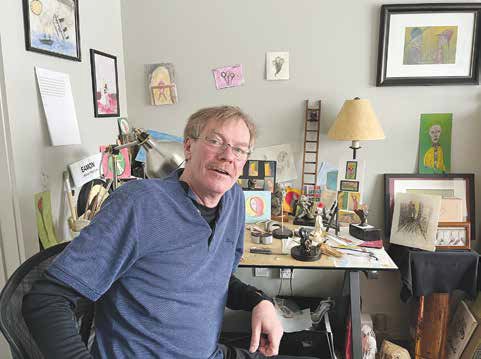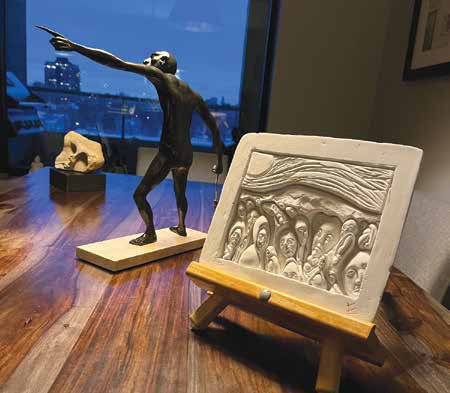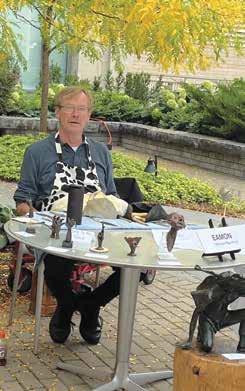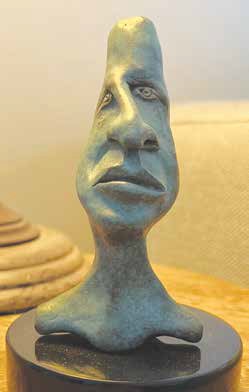Tanis Browning-Shelp
Michael FitzPatrick the journalist and media/communications specialist lives with his wife Sally at The Corners on Main in Old Ottawa East. Michael FitzPatrick the artist goes by the name “Eamon” and refers to his artworks as “Expressions of Eamon.” Eamon is FitzPatrick’s second name. “I was born an Irish Catholic,” he says.

OOE resident Michael FitzPatrick, who creates provocative sculpture using the name Eamon, seen here at work in his home studio. Photo by Sally Fitzpatrick
FitzPatrick worked covering politics for 23 years. “I filed stories from 19 countries, including two war zones, and worked for CTV National in Toronto, Montreal, and Global National on Parliament Hill in Ottawa.”
By education, FitzPatrick is a physical anthropologist/archaeologist. “By inclination, however, I am a sculptor,” he says. “The anatomy courses I took transferred over into my art. All of my sculptures start with faces and heads.”
Eamon has been sculpting and exhibiting for over 40 years and his works are in private collections across Canada, the U.S., France, Ireland, and England. “My work is about the human condition. I try to capture the emotions, attitudes, and feelings of humans—all humans.”
His work is autobiographical. “It started within me and was born of me. I have always been an artist. When I was a kid, I climbed up trees and looked into nests in order to draw them. I painted watercolours and drew with coloured pencils.”
Art, Eamon believes, is a conversation. “In the case of my art, it may provoke conversation! We have struggled with our existence from the moment that we became aware of it. Perhaps, through introspection, we can sort through the rhymes and reasons for being here and collectively we can continue to explore the astonishment of existing.” When Eamon was in university, he would use cross hatching in his drawings because he wanted his works to have three dimensions. “Eventually, I thought, why not actually work in three dimensions?”
“My first plan was to make a Tolkienthemed chess set. But that never happened. Once I had the clay in my hands and started manipulating it, I began to see things. It is always a face that emerges. Even when I work with soap stone, I look at it until I see something in the raw piece. I can say with certainty that I have never planned a piece. But what better way to try and understand an ethereal, philosophical aspect of existence than trying to materialize it into a threedimensional object?”
Eamon’s sculptures range in size from three inches to fifteen inches in height. The themes in his works are Politics (The Two Solitudes, The Politician, and The Foot Soldier); Religion (The Archangel, Faith, Vengeance, Guilt, and Reparation); and Personal (Victim of Circumstance, and Memories). The faces in his art are intense. “They are definitely not happy,” he says. Many of his pieces are peppered with hidden heads and faces. “You have to turn them around to find them all.”
Eamon is a member of the Sculpture Society of Canada and Past President of the National Capital Network of Sculptors. He has exhibited his work 96 times and has been the in-house sculptor for several galleries. “We have lived in Ottawa since 1984, except for one year when we lived in Ireland.”
Eamon doesn’t go anywhere without his “little bag of tricks” – some clay and a few tools. “I work on my pieces when I’m out for dinner, visiting somebody in a bar, attending an OOE Life Drawing class, or travelling on an airplane. I was busy polishing a soapstone sculpture one day back in the 80s when somebody suggested that I get my work cast into bronze. I had never thought of doing that, but I was intrigued. I started out going to a foundry near Montebello, Quebec. Later, I changed to one in Georgetown, Ontario called Artcast, where the quality of their work was even better.”

Three of Eamon’s sculptures on a table. From nearest to farthest, Field of Dreams (plaster of Paris), Vengeance (bronze), and Memories of Minos (Brazilian soapstone). Photo by Eamon
The bronzing process begins with the artist creating an original sculpture in clay, Plastelina or plaster. “The foundry then encases your piece and creates a rubber mold. Sometimes the original gets destroyed. Artcast has been very good at preserving my originals and that’s not easy to do given how tiny certain aspects of my work can be. They pour wax into the mold to create a wax version that gets encased in ceramic material. They heat it up and pour out the wax. That’s when they have a negative. That’s when you pour in the bronze.”
The patina/colour of the bronze is another area where the artist gets involved. “Artists develop their own formulas/recipes for patinas. There are books filled with the recipes/formulas for different colours. It used to be that you were allowed to bronze a sculpture seven times and still call each of them originals. Today you are allowed twelve. I’ve never gone beyond four because of the cost of bronzing.”
Eamon refers to one of his bronzed works, a three-inch-tall, bronzed sculpture called Rapa Nui. “The rubber mold cost me $300, the wax $50, the bronze $300, and the marble base $40 for a total of nearly $700, but I can only sell the piece for $200-$250.”
Recently, Eamon created and sold a sculpture in Brazilian soapstone. “I kept a portion of the piece in its raw form and carved out the face. I used wet/dry sandpaper over a number of weeks to polish the carved part and then oiled it with Tung oil. I like having the contrast between the raw and the polished stone. He is also currently writing his first book with the working title It’s All in Your Head: A Fable About Myths.
![]() Author Tanis Browning-Shelp (http://www.browning-shelp.com) pens her Maryn O’Brien Young Adult Fiction series, published by Dog-Eared Books, from her home in Old Ottawa East. Contact tanis@browning-shelp.com if you have information about artists or art events that you believe would enrich our community members’ lives.
Author Tanis Browning-Shelp (http://www.browning-shelp.com) pens her Maryn O’Brien Young Adult Fiction series, published by Dog-Eared Books, from her home in Old Ottawa East. Contact tanis@browning-shelp.com if you have information about artists or art events that you believe would enrich our community members’ lives.








